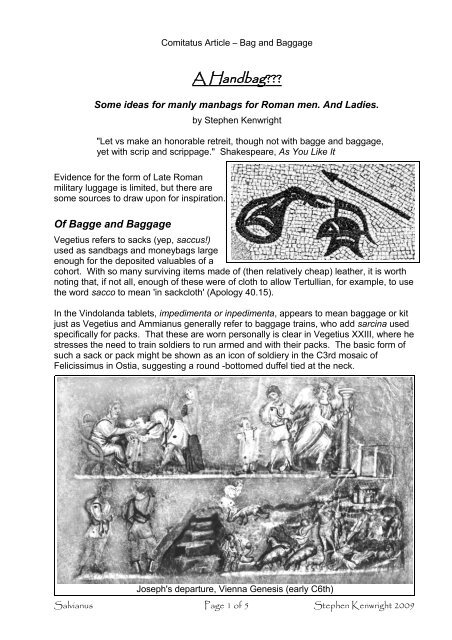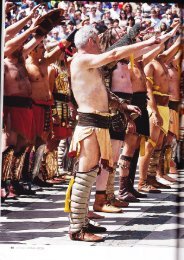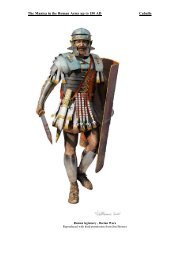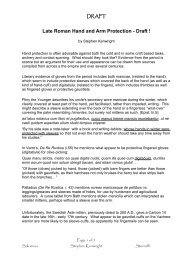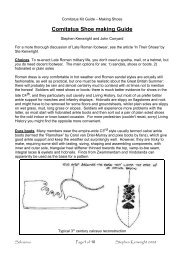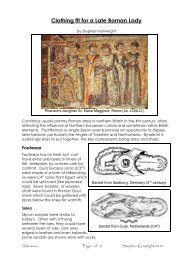A Handbag??? - Comitatus
A Handbag??? - Comitatus
A Handbag??? - Comitatus
Create successful ePaper yourself
Turn your PDF publications into a flip-book with our unique Google optimized e-Paper software.
<strong>Comitatus</strong> Article – Bag and Baggage<br />
A <strong>Handbag</strong>???<br />
Some ideas for manly manbags for Roman men. And Ladies.<br />
by Stephen Kenwright<br />
"Let vs make an honorable retreit, though not with bagge and baggage,<br />
yet with scrip and scrippage." Shakespeare, As You Like It<br />
Evidence for the form of Late Roman<br />
military luggage is limited, but there are<br />
some sources to draw upon for inspiration.<br />
Of Bagge and Baggage<br />
Vegetius refers to sacks (yep, saccus!)<br />
used as sandbags and moneybags large<br />
enough for the deposited valuables of a<br />
cohort. With so many surviving items made of (then relatively cheap) leather, it is worth<br />
noting that, if not all, enough of these were of cloth to allow Tertullian, for example, to use<br />
the word sacco to mean 'in sackcloth' (Apology 40.15).<br />
In the Vindolanda tablets, impedimenta or inpedimenta, appears to mean baggage or kit<br />
just as Vegetius and Ammianus generally refer to baggage trains, who add sarcina used<br />
specifically for packs. That these are worn personally is clear in Vegetius XXIII, where he<br />
stresses the need to train soldiers to run armed and with their packs. The basic form of<br />
such a sack or pack might be shown as an icon of soldiery in the C3rd mosaic of<br />
Felicissimus in Ostia, suggesting a round -bottomed duffel tied at the neck.<br />
Joseph's departure, Vienna Genesis (early C6th)<br />
Salvianus Page 1 of 5 Stephen Kenwright 2009
<strong>Comitatus</strong> Article – Bag and Baggage<br />
In the early C6th Vienna Genesis we see Joseph in Late Roman dress being sent to check<br />
on his brothers by Israel from Genesis 37:13 - taking his leave, led by an angel and getting<br />
directions before crossing from Hebron to Shechem, where he is attacked. His sack-like<br />
pack is formed from pink material, probably a cloak, wrapped round and, I think, ligatured<br />
with string at either end of the load to keep it in place, then slung across the body and<br />
knotted at the front to fasten. This method is familiar from the American Civil War,<br />
nicknamed a 'mule collar', although bulkier than the neat blanket roll often seen. It has<br />
been tested on marches by members of <strong>Comitatus</strong> and found to be stable and comfortable<br />
once packed correctly, although obviously warmer and less ergonomic than a modern<br />
strapped rucksack and with the potential to weigh on the chest. One tip is not to include<br />
your only rain-cover!<br />
Subdivision of the load is suggested by the C4th Deurne helmet was apparently supplied<br />
with a drawstring bag 35.5cm X 38cm made from two pieces of calfskin for protection,<br />
presumably inside the larger bundle made by a goatskin sheet that can be interpreted as a<br />
one-man tent panel.<br />
Of Scrip and Scrippage<br />
sed nunc qui habet sacculum tollat similiter et peram<br />
"But now they who have a purse, let them take it, and likewise a satchel"<br />
Luke 22:36 (Jerome's Vulgate)<br />
The 4th century Vulgate's 'pera' continues<br />
directly from the Greek πήρα, with connotations<br />
of 'provisions bag', 'bread bag' and perhaps<br />
sometimes a 'begging bag': in Martial's epigram<br />
(XIV:81) a pera pleads 'that it may not be obliged<br />
to carry the beggarly food of a long-bearded,<br />
half-clad philosopher (who does that remind me<br />
of?), or serve as pillow to his mangy dog'. In<br />
1 Samuel 17:40 David puts his selected slingstones<br />
in peram pastoralem quam habebat<br />
secum 'into a shepherd's bag that he had with<br />
him'. This is presumably similar to the bags often<br />
seen when Christ is depicted as 'the Good<br />
Shepherd' in Late Roman iconography, and this I<br />
have chosen to use as a model for my own<br />
'manbag' which Helena constructed for me from<br />
linen, in a rectangular box shape. The pera<br />
pictured seems to have a removable strap,<br />
perhaps to allow the bag to be washed without<br />
damaging the leather.<br />
Women might carry a smaller perula with them<br />
(Quintilian, Institutio Oratoria, Book VIII.3:54),<br />
but Judith's maid (13:11) happens to have a<br />
pera with her, handily large enough to conceal<br />
Holofernes' severed head. These modern girls!<br />
Marble statue of the Good Shepherd<br />
(Vatican Museum, C3rd, legs restored).<br />
Salvianus Page 2 of 5 Stephen Kenwright 2009
Bath procession (Piazza Armerina C4th)<br />
<strong>Comitatus</strong> Article – Bag and Baggage<br />
Qasr Ibrim textile bag (C1st)<br />
A first-century find from Qasr Ibrim, Egypt, looks reminiscent of a red servant's bag shown<br />
worn relatively high under the arm in a Piazza Armerina mosaic. Once on a cliff-top<br />
overlooking the Nile in Lower Nubia, now the far south of Egypt, the fort was left on an<br />
island in Lake Nasser by the construction of the Aswan High Dam. The site dump<br />
contained a mass of what was identified as Roman type refuse from the Roman<br />
occupation in the Augustan period, including many textiles.<br />
The bag is made from five pieces of undyed flax, like 2 triangles sewn together part of the<br />
way up, with a wide base supported by the pointed top ends, which were tied in a square<br />
knot. One side is a single piece woven selvedge to selvedge, with the opposite side made<br />
of the other four pieces. The base is 33cm wide, which has narrowed to 20cm wide by the<br />
opening, the 'pouch' being 50cm high on one side and 43cm on the other, with the 'straps'<br />
continuing 40 and 30cm farther above the opening (Adams and Crowfoot 2001). The<br />
construction resembles modern versions of the Thai yaam shoulder bag and the authors<br />
identified it as a shoulder bag, but if tied off to be carried over the shoulder or thrown on a<br />
wagon I think the shape when full would be more like the Ostia mosaic bag.<br />
Salvianus Page 3 of 5 Stephen Kenwright 2009
In the above passage from Luke sacculus<br />
or 'little bag' apparently translates the<br />
Greek word βαλλάντιον (ballantion)<br />
suggesting a container one throws things<br />
into, associated with coins, hence I like<br />
'purse'. It is also used for a bag holding<br />
weights for trading (Deuteronomy 25:13).<br />
Jerome also includes the term<br />
marsupium in the sense of a purse (from<br />
marsippion, diminutive of marsippos<br />
'pouch' whence the infraclass of<br />
mammals, Proverbs 1:14).<br />
Statues of Mercury, copied from Greek<br />
originals of Hermes in his guise as the<br />
patron of commerce, often carried a<br />
distinctive purse bearing three tassels.<br />
The figurine pictured shows clearly a<br />
'drawstring' opening. These can be made<br />
very simply from a circle of thin leather<br />
(nearly three times the desired height!),<br />
with holes punched for a drawstring in<br />
from the edge to give a generous closure.<br />
Such a drawstring purse containing a<br />
large amount of money from the late<br />
C2nd was found at Barger-Compascuum<br />
in the Netherlands province of Drenthe. It<br />
was about 22cm X 26cm, with a divider<br />
inside and a leather toggle to close the<br />
drawstring, which may have been used to<br />
suspend it from a belt, although it is big.<br />
A leather wallet of a woman's legal papers<br />
spare thread and a mirror from the mid<br />
130s was found in the 'Cave of Letters',<br />
Israel, resembling a classic rectangular<br />
tobacco pouch about 23cm X 12cm with a<br />
semicircular flap and I use something<br />
similar for concealing my modern items<br />
within my pera.<br />
<strong>Comitatus</strong> Article – Bag and Baggage<br />
Bronze figurine of Mercury holding a<br />
moneypurse (Louvre C1st–2nd A.D.)<br />
It does seem reasonable that the<br />
suspension rings on military belts might<br />
have held pouches and a small<br />
rectangular one can be discerned on the<br />
Dura Europos wall painting of the Cohors Barger-Compascuum money-pouch, late C2nd<br />
XX Palmyrenorum sacrificing. These<br />
(after Schlabow 1956)<br />
might have held the sort of items found with soldiers Paul Browne mentioned in his<br />
article in the last newsletter, such as combs, spoons, whetstones, tweezers and<br />
possibly tinder pouches with a fire steel on the front, like those found in Anglo-Saxon<br />
graves. I suspect coin-purses would be tucked away for safekeeping, possibly in<br />
Salvianus Page 4 of 5 Stephen Kenwright 2009
<strong>Comitatus</strong> Article – Bag and Baggage<br />
something akin to the small rectangular neck pouches such as appear on early<br />
imperial memorial monuments. I keep a lead tag with my name and unit on it in<br />
mine.<br />
In Matthew 10:9 we find the zona, or girdle used for carrying money, and thus perhaps<br />
'money-belt', just as in the (probably 4th century) Historia Augusta, Pescennius is<br />
described wishing to avoid the sarcinae milites 'baggage of the soldiers', or other booty<br />
falling into enemy hands:<br />
idem iussit, ne zona milites ad bellum ituri aureos vel argenteos nummos portarent,<br />
sed publice commandarent<br />
He gave orders, likewise, that the soldiers should not carry gold or silver coin in their<br />
money-belts when about to go into action, but should deposit them with a designated<br />
official.<br />
I'll happily volunteer (see you in the caupona!).<br />
Select Bibliography<br />
Adams, N.K. and Crowfoot, E. (2001) 'Varia Romana: Textiles from a Roman Army Dump'<br />
in R. P. Walton, L.B. Jørgensen and A. Rast-Eicher (eds.), The Roman Textile Industry<br />
and its Influence, A Birthday Tribute to John Peter Wild, 31 Oxbow Books, Oxford.<br />
Bishop, M.C. and Coulston, J.C.N. (2006) Roman Military Equipment: From The Punic<br />
Wars To The Fall Of Rome. 2 nd ed. Oxford: Oxbow.<br />
Schlabow, K. (1956) 'Der Romische Munzschatz von Barger-Compascuum (Drenthe) II<br />
Der Geldbeutel', Palaeohistoria 5, 81-88.<br />
Salvianus Page 5 of 5 Stephen Kenwright 2009


